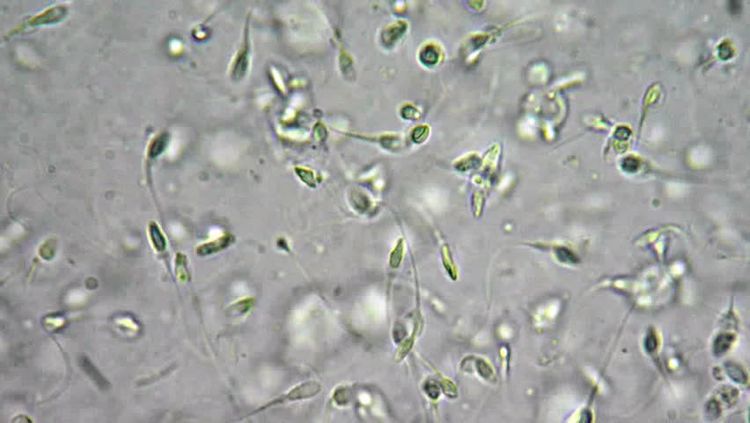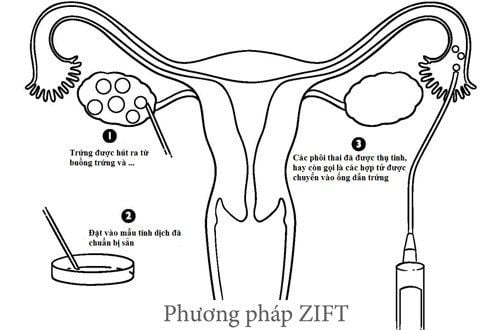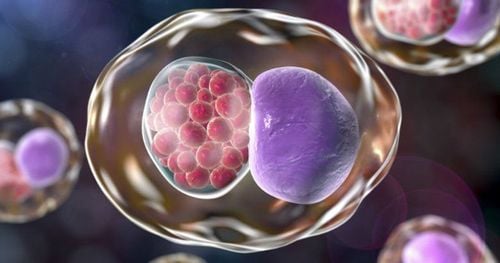This is an automatically translated article.
In vitro zygoteotic transfer (ZIFT) is similar to in vitro fertilization (IVF) and gamete intra fallopian tube transfer (GIFT), but in this procedure the egg is fertilized in a laboratory before Your doctor places them inside your fallopian tubes. These fertilized eggs are called zygotes (one-celled embryos that have not yet begun to divide into many cells).
1. What is zygote transfer into the fallopian tube?
Zygozygotes in fallopian tubes (ZIFT) is an infertility treatment used when there is a blockage in the fallopian tubes that prevents the normal fusion of sperm with an egg. Egg cells are removed from a woman's ovaries and fertilized in a test tube. The resulting zygote will be placed in the fallopian tube by laparoscopy. This method is a step forward of gamete intra-fallopian transfer (GIFT). The pregnancy and implantation rates in the ZIFT cycles were 52.3 and 23.2%, respectively, higher than what was observed in the IVF cycles of 17.5 and 9.7%.
ZIFT is the most invasive fertility treatment, that's why it's rarely done anymore. ZIFT accounts for less than 1% of assisted reproductive technology (ART) procedures.
2. How is ZIFT specified?
ZIFT is an option if other treatments have failed and you have at least one working fallopian tube. ZIFT may also be ordered if you have:
Unexplained infertility Ovulation problems Your partner has a low sperm count If your partner's sperm count is very low or if there are fertility problems fertilization during your previous IVF cycles, ZIFT can be used with intracytoplasmic sperm injection (ICSI) - a procedure that increases the chances of fertilization by injecting a single sperm most directly into the egg.

Số lượng tinh trùng thấp cần được chỉ định chuyển hợp tử trong ống dẫn trứng (ZIFT)
3. How does ZIFT work?
Some of the first steps of ZIFT are similar to those of IVF:
Ovarian stimulation. During the first few days of your period, you take medication to stimulate the ovaries to develop mature eggs and to prevent the body from releasing an egg too soon. Follicular development. While taking these medicines, you should visit your doctor's office or clinic every two to three days so your doctor can check your blood hormone levels and have an ultrasound measure your growing follicles - the sacs filled with the liquid where the eggs mature. Collect eggs. When the eggs are ready to be retrieved, your doctor will anesthetize and insert an ultrasound probe through your vagina to look at your ovaries. Once she identifies the cysts, a thin needle will be inserted through the wall of your vagina to remove about 8 to 15 eggs.
Fertilization. An embryologist (a scientist who specializes in the study of eggs, sperm, and embryos) then combines your eggs with your partner's sperm in a lab and watches them closely for fertilization. About a day later, each successfully fertilized egg becomes a single-celled embryo called a zygote. Next steps are different from IVF:
Surgery. When the zygote develops, the doctor will perform minor surgery. After giving you anesthesia, your doctor will make a small incision in your abdomen. The doctor then uses a thin, lighted microscope (laparoscope) to transfer one to five zygotes into the fallopian tubes. Women often have some pain after surgery. Any excess zygotes can be frozen if treatment is unsuccessful. Successful embryo implantation. If the treatment works, the zygote will travel through the fallopian tube and implant in the uterus, where it develops into a baby. If more than one zygote is transferred, your chances of getting pregnant are higher, but so is your risk of having twins, triplets, or more. Pregnancy test. You can take a pregnancy test about two weeks after surgery.
4. How long does ZIFT take?
It takes 4 to 6 weeks to complete a cycle of ZIFT treatment, starting with fertility drugs and ending with a pregnancy test.
You have to take fertility drugs and wait for the eggs to mature. Then you and your partner spend about half a day at the doctor's office or clinic collecting eggs and sperm.
The next day, the zygotes are surgically transferred to your fallopian tubes. The pregnancy test takes place about two weeks later.

Phương pháp chuyển hợp tử trong ống dẫn trứng (ZIFT)
5. What is the success rate for ZIFT?
Success rates for ZIFT vary widely, depending on fertility problems and a couple's age. Younger women often have healthier eggs and higher success rates. Women have about a 22% chance of having a baby with each ZIFT cycle - similar to IVF success rates.
6. What are the advantages of ZIFT?
The fertilized egg. ZIFT is a little more reassuring than GIFT because the doctor confirms that the egg has been fertilized before it is placed in the fallopian tube. Natural transplant. ZIFT allows a developing embryo to travel on its own, which may appeal to you if you want your baby to develop as naturally as possible (although there's no medical reason why fertilisation). natural sperm is preferable to assisted fertilization). Not linked to cancer. Recent studies show no link between ovulation-stimulating drugs and cancer. Early studies suggest that exposure to fertility drugs may lead to an increased risk of ovarian cancer or other cancers of the female reproductive system.
7. What are the disadvantages of ZIFT?
Very expensive price. ZIFT involves expensive lab work, medications, and surgery. Waste time. Keeping track of fertility drugs takes time, with frequent visits to your doctor's office for blood tests and ultrasounds. Hard to find. Many fertility clinics don't even offer ZIFT as an alternative treatment. Requires surgery. Transferring the zygote into your fallopian tubes requires invasive surgery, unlike IVF. More likely to have multiples. Because many of the zygotes are usually transferred to the fallopian tubes, you're more likely to have twins or more. Although many couples consider this a blessing, having multiple pregnancies increases the risk of miscarriage and other complications. Other health risks. As in IVF, women who use ZIFT have a higher risk of preterm or low birth weight delivery. If your body responds too well to fertility drugs, you may have ovarian hyperstimulation syndrome (OHSS). And while all ART treatments carry a higher risk of ectopic pregnancy, the risk is higher with ZIFT than with IVF. It may not work. Your treatment may be canceled if you develop OHSS or if not enough follicles develop.

Để lựa chọn phương pháp hỗ trợ sinh sản tốt nhất, các cặp vợ chồng nên tìm đến cơ sở y tế uy tín
8. How much does ZIFT cost?
In the US, expect to spend about $15,000 to $25,000 on a cycle of ZIFT. ZIFT is more expensive than IVF or GIFT. Amounts vary, depending on how much medication you need, where you live, and whether your state mandates coverage for fertility treatments. If your policy doesn't cover the procedure, you may have to pay the full cost upfront.
Vinmec IVF Reproductive Center is the address of infertility - infertility treatment chosen by many couples. So far, the Center has performed fertility support for over 1000 infertile couples with a success rate of over 40%. This rate is equivalent to developed countries such as the UK, USA, Australia,...
The center gathers a team of leading experts in the field of obstetrics and gynecology nationally and internationally, trained in centers leading in the world such as in the US, Singapore, Japan, Australia and famous fertility centers in the world.
With a high level of expertise and extensive experience, Vinmec IVF Center's experts are capable of synchronously and comprehensively deploying the most advanced assisted reproductive techniques today, helping realize the dream of becoming a parent of hundreds of families across Vietnam.
Please dial HOTLINE for more information or register for an appointment HERE. Download MyVinmec app to make appointments faster and to manage your bookings easily.
Reference source: babycenter.com












